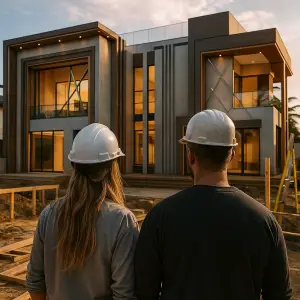The Role of Airtightness in Creating Comfortable Living Spaces
Airtightness plays a pivotal role in enhancing the comfort, energy efficiency, and overall quality of living spaces within buildings. In a world increasingly focused on sustainability and reducing carbon footprints, airtightness emerges as an essential component in achieving these goals. Through its myriad benefits and mechanisms, airtightness profoundly influences how we live, the energy we consume, and the bills we pay.
Energy Efficiency and Reduced Carbon Emissions
Airtightness is instrumental in curtailing air leakage in the building envelope, which is crucial for minimizing energy loss. By preventing uncontrolled air infiltration and exfiltration, airtight buildings can drastically reduce their heating and cooling demands.
- Lower Energy Bills: Reduced energy consumption naturally leads to lower energy bills, providing homeowners and businesses alike with significant cost savings over time.
- Operational Carbon Emissions: Less energy use translates to reduced operational carbon emissions. More efficient heating and cooling systems consume less energy, thus assisting in achieving a more sustainable and eco-friendly world.
Airtightness contributes to a more sustainable environment by reducing the need for constant heating and cooling, thereby helping to meet carbon reduction targets.
Improved Indoor Air Quality
Airtight homes enable better control over ventilation systems, ensuring that fresh and filtered air circulates throughout the living spaces.
- Healthier Indoor Environment: Proper mechanical ventilation in airtight homes is crucial for maintaining healthier living environments by keeping allergens, pollutants, and other harmful contaminants at bay.
- Consistent Air Quality: By maintaining a steady flow of clean air, airtightness improves indoor air quality, contributing to increased well-being and comfort for the building’s occupants.
Ensuring optimal air quality is essential, particularly as many individuals spend a significant amount of their time indoors.
Enhanced Thermal Comfort
Airtightness plays a key role in eliminating drafts and cold spots within a building, providing a more consistent and comfortable indoor environment.
- Stable Temperatures: High-performance homes benefit from stable temperatures, eradicating uncomfortable temperature variations from room to room.
- Overall Comfort: Enhanced thermal comfort is directly linked to the well-being and quality of life for residents, impacting everything from mood to productivity.
The consistency provided by airtightness ensures that living spaces remain pleasant regardless of external temperatures.
Moisture Control
Airtightness is also essential for effective moisture control in buildings.
- Reduced Condensation: Minimising air leakage greatly reduces the chances of condensation, which can lead to mould growth and rot if unchecked.
- Healthier Living Spaces: By controlling moisture intrusion effectively, airtightness promotes healthier and more durable living spaces.
Airtightness provides protection against moisture, ensuring that buildings remain robust and healthy over time.
Construction and Testing
Achieving optimal airtightness involves the application of specific construction techniques.
- Sealing Gaps and Openings: Construction efforts focus on sealing gaps and unsealed openings in the building envelope to prevent unwanted airflow.
- Air Permeability Testing: This step is crucial for ensuring airtightness targets are met, particularly in adherence to building regulations. In the UK, airtightness testing has been mandatory for new buildings since 2006, a regulation designed to demonstrate compliance with Part L of the building regulations.
Airtightness testing is a vital step towards enhancing a building’s energy efficiency and overall performance.
Role of Airtightness Testing as per Ratio Seven
Ratio Seven is committed to implementing airtightness testing to reduce operational carbon emissions. The benefits are numerous:
- Identifying and Remedying Air Leakage: Airtightness testing uncovers areas of air leakage in the building envelope, enabling targeted improvements to minimise air infiltration and exfiltration.
- Energy Consumption and Carbon Emissions: More effective airtightness translates to reduced energy requirements for maintaining comfortable indoor temperatures, thus lowering energy consumption and carbon emissions. This also reduces wear and tear on HVAC systems, leading to lower maintenance costs.
- Comprehensive Testing Services: Ratio Seven offers detailed airtightness testing services that include reports and improvement recommendations. These services are designed to help buildings achieve optimal airtightness, thereby enhancing energy efficiency and reducing operational carbon emissions.
Ratio Seven’s role in the process is indispensable, providing expert services essential in the pursuit of comfort and sustainability.
The Impact of Airtightness on Building Lifespan
Airtightness not only contributes to immediate benefits such as energy efficiency and indoor air quality but also extends the lifespan of a building:
- Durability: By preventing the intrusion of moisture and air pollutants, airtight buildings are less prone to damage and deterioration, thus enhancing their longevity.
- Reduced Maintenance Costs: With fewer issues stemming from air leaks and moisture, the costs associated with repairs and maintenance are significantly decreased, making airtightness a cost-effective investment.
The long-term benefits of airtight constructions add tremendous value to property owners and tenants alike.
The Future of Living Spaces with Airtight Construction
As the demand for sustainable and energy-efficient buildings continues to rise, airtight construction methods are becoming an integral part of future architectural strategies.
- Innovative Materials and Techniques: Advancements in building materials and construction techniques are continuously emerging, enhancing the ability to achieve efficient airtight living spaces.
- Regulatory Standards: With increasing global regulatory standards regarding energy consumption and carbon emissions, airtightness will likely remain a critical focus for builders and developers worldwide.
The future looks promising as more stakeholders are becoming cognizant of airtightness benefits, ensuring healthier, more sustainable living spaces.

FAQs
What is the role of airtightness in reducing energy bills?
Airtightness restricts the flow of uncontrolled air through a building’s envelope, which helps to maintain stable indoor temperatures without relying heavily on heating and cooling systems. As a result, energy consumption is reduced, leading to significant savings on energy bills. Efficient energy use in buildings enhances sustainability and is a proactive measure towards reducing carbon footprints.
How does airtightness improve indoor air quality?
Airtight buildings facilitate controlled ventilation, ensuring that all circulated air is fresh and filtered. By preventing unfiltered outside air and contaminants from entering the building, airtight homes maintain a healthier indoor environment. This process is particularly important in reducing the presence of allergens and airborne pollutants, promoting better respiratory health and overall well-being for occupants.
Why is airtightness important for moisture control in buildings?
Airtightness prevents air leaks that can carry moisture within a building’s structure, reducing the risk of condensation, mould growth, and subsequent structural damage. By controlling moisture ingress, airtight buildings ensure a healthier interior environment and help preserve construction materials, contributing to a building’s enhanced durability and lifespan.
In summary, the role of airtightness in creating comfortable living spaces is a multifaceted one, encompassing aspects such as energy efficiency, thermal comfort, and indoor air quality. By employing effective airtight construction techniques and comprehensive testing services like those offered by Ratio Seven, buildings can reach their full potential in delivering sustainable and comfortable environments. With the increasing awareness and the demand for eco-friendly building solutions, airtightness stands out as a cornerstone for developing the buildings of tomorrow, ensuring substantial economic and environmental benefits for years to come.
Exploring Further into Airtight Future
The transition to greener and more efficient living environments clearly highlights the role of airtightness as an indispensable factor.
As society becomes more connected to sustainability goals, the importance of airtight buildings only grows, reflecting a commitment to better building practices that support a healthier planet while also enhancing everyday living experiences.




